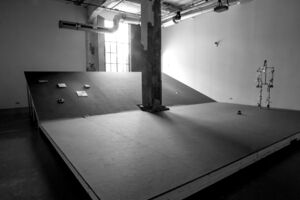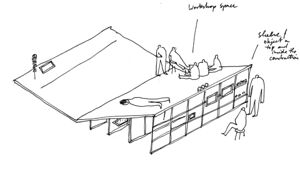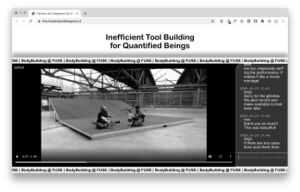Publishing:Making Matters Lexicon/Platform
platform
a platform design request
In recent years the Hackers & Designers collective[1]
has been frequently approached by organizations and initiatives from the fields of art, design, technology, and academia with the question: ‘Do you want to design our platform?’ An intricate question as the term platform refers to a multitude of phenomena and objects. The platform’s ambiguity seems particularly amplified when articulated as part of a design brief, suggesting that the platform is to be an expansion of the realm of designed things.
An organization as platform supports individuals or groups in addressing an audience. In a computational context, the term platform refers to a technical infrastructure, for instance an environment in which software applications are designed, deployed, or used, such as computer hardware, operating systems, gaming devices, mobile devices.[2]
With the H&D collective we have designed, built, and maintained technical infrastructures, such as software, webware, and services that enable online collaboration, production, organization, and publishing of digital content. Such diy platforms are tool convergences that—in their particular composition—cater to the particular needs of the collective. They are content management systems,[3] chat applications,[4] collaborative writing tools,[5] online spreadsheets[6] and file sharing systems.[7] These self-made, appropriated or hacked tools and systems are implicated in the ways the members of the collective work together. H&D’s technical infrastructure continuously evolves, and at times fails, or acts in an unexpected way. H&D shapes and reshapes its modes of organizing around the possibilities and limitations of such self-made platforms—along with learning to cope with system incompatibilities, broken links, expired protocols, and unreliable backups. Therefore, the notion of platform is at the core of its existence.
The platform-design request implies that a platform can be regarded as separate from its context, and that there is a causal relationship between platform and design. However, because of how the H&D collective has developed relationships with technical infrastructures
it would be difficult to disconnect the technical aspects from the organizational and social aspects of platforms. The question then arises whether platforms—in the way
we relate to them at H&D, as an inherent part of the collective’s fabric, including its characteristic of constant emergence, spontaneity, and unreliability—
can be designed at all?
In my view, the question: ‘Do you want to design
our platform?’ wrongly implies a certain fixedness,
a beginning and an end of a digital platform
and the possibility to foresee a platform’s trajectory.
The ‘commissioners’ who formulated the request position themselves as end users of the platform, and suggest some kind of ownership of it. It would be ‘their’ platform that ‘we’ are designing. However, a platform, as I see it, in its manifold of meanings is interwoven in collective practice and cannot be owned.
thinking with platforms
Besides its technical connotations, the term platform is also often used figuratively, for instance referring to organizations such as H&D. As such, it tends to assign an assumed value to the platform-organization as supportive and enabling, and risks a flattening of the technical and organizational particularities and implications of a collective. The question is how to think with the various meanings of ‘platform’? How do platform’s different (technical, organizational, architectural, political) connotations intersect—act together and apart?
In 2020, H&D developed a physical structure,[8] the ‘H&D platform’, together with architectural designer Thomas Rustemeyer. The installation was meant to represent the H&D collective in its endeavour to bring together different practitioners, artists, designers, and computer programmers[9] and facilitate exchanges among them. The platform would be activated at different moments, for instance as a workshop space, a stage for performances and presentations, and as a reading room.
However, due to the global Covid-19 pandemic the platform as we had initially envisioned it remained more or less unvisited and untouched. Yet, through the sudden need for our planned activities to continue online, we developed other, digital, means of pursuing our activities. For instance, we created a project website that showcases the work of the contributing artists[10] and draws together their research and process documentation. We furthermore developed the ‘H&D livestream platform’ as we witnessed an increasing fatigue of commercial platforms. The fatigue is caused by large tech companies such as Google, Facebook, Microsoft or Zoom, who profit from their user’s reliance upon them in times of crisis by selling their data.[11]
The H&D livestream platform converges an open-source streaming software, a streaming service, and a chat interface.[12] Certainly less clumsy ‘off-the-shelf’ platforms do exist. The H&D livestream platform ‘acted up’ and caused moments of discomfort through its glitches and lags. However, it sustained its appearance, and has hosted many online H&D events in different contexts.
In the context of H&D, the collective seems to establish intrinsic relationships with digital tools and technical infrastructures that expand the realm of utility. An important part of building and maintaining such relationships are the manners in which the collective copes with unreliability, exercising patience and curiosity towards unintended technical glitches. In such a context, platforms can therefore not be described as self-contained entities. They travel between a multiplicity of meanings and inhabit collective peculiarities, as they are designed and redesigned in action and through interaction, which, in my view, makes it impossible to uphold a user-designer distinction.
To recap, a self-organized collective such as H&D shapes itself through technical infrastructures. In turn, technical infrastructures also continuously evolve with the collective, oftentimes in unpredictable ways. The emerging technical infrastructure around the aforementioned exhibition project is an example of that. Through their co-evolvement with collective practice, such platforms can therefore not be described as disconnected from collectivity.
- ↑ Hackers & Designers is a non-profit workshop initiative organizing activities at the intersection of technology, design, and art. The larger H&D community consists of a growing pool of international makers from diverse backgrounds. The aim of H&D is to stimulate and support exchange, learning and collaborations within this larger network of soft- and hardware developers, designers, artists, and researchers, and to create inspiring and encouraging spaces for the community to share skills, urgent topics, and interests, as well as concrete offers for commissions, exhibitions, guest lectures and workshop facilitation.
- ↑ Tarleton Gillespie, ‘The Politics of “Platforms”’, New Media & Society 12, no. 3 (May 2010), pp. 347–64.
- ↑ hackersanddesigners.nl/s/Publishing/p
/The_making_of_hackersanddesigners.nl. - ↑ hackersanddesigners.nl/s/Tools/p/Chattypub.
- ↑ hackersanddesigners.nl/s/Tools/p/Free_Wiki.
- ↑ hackersanddesigners.nl/s/Tools/p/H%26D_Ethercalc.
- ↑ hackersanddesigners.nl/s/Summer_Academy_2020
/p/Becoming_a_Server. - ↑ Tetem – Presentatieruimte & platform voor Digitale cultuur en MaakCultuur, tetem.nl/.
- ↑ Contributing artists: Nazanin Karimi, Kiki Mager,
The Underground Division (Jara Rocha, Helen Pritchard, Femke Snelting), Thomas Rustemeyer. - ↑ bodybuilding.hackersanddesigners.nl/.
- ↑ theverge.com/interface/2020/4/2/21202984/zoom-backlash-zoombombing-encryption-exploits-consumerization-of-it; www.cyberscoop.com/zoom-fbi-teleconference-hijacking/; www.techradar.com/reviews/zoom.
- ↑ hackersanddesigners.nl/s/Tools/p
/H%26D_livestream.


